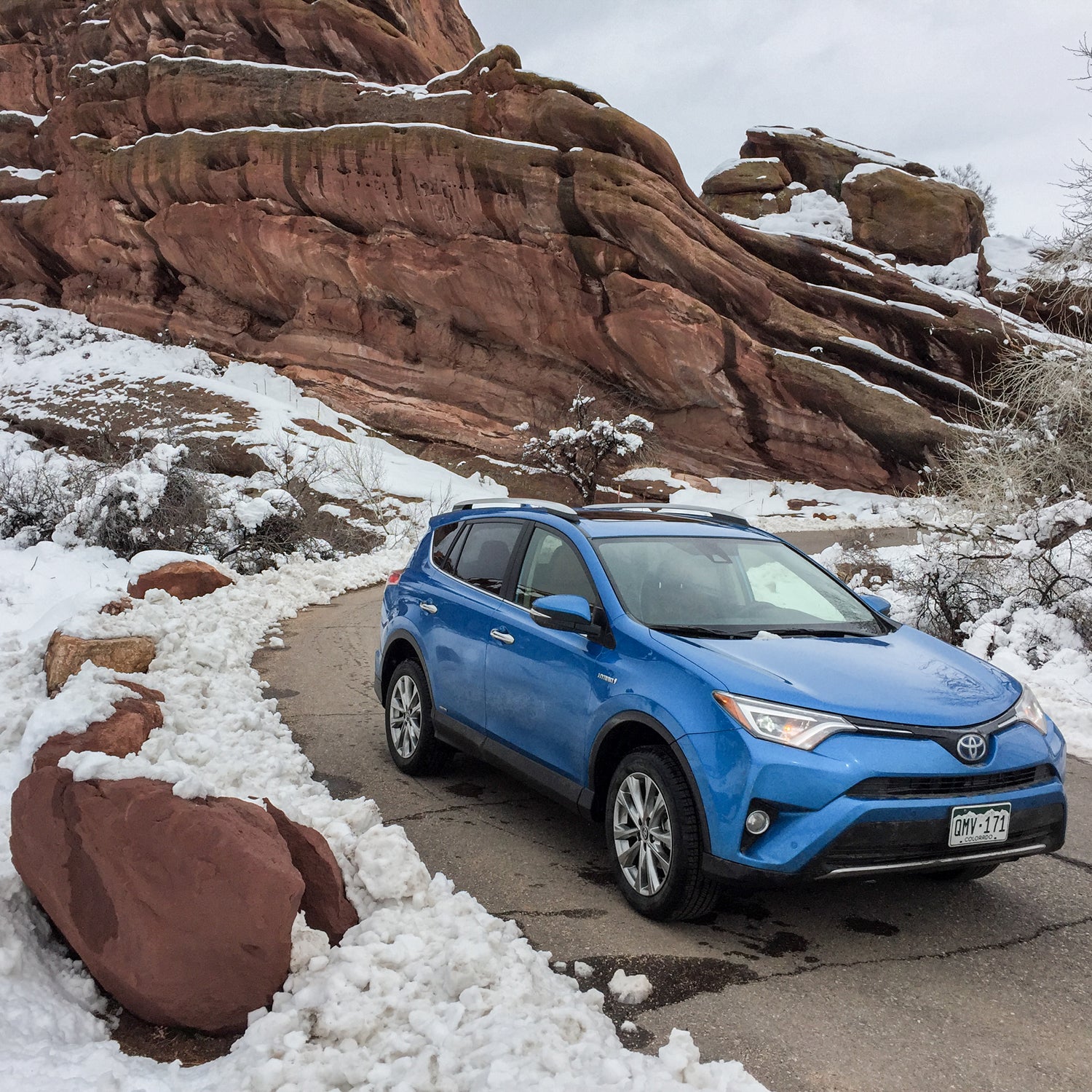The聽RAV4 Hybrid definitely wins sleeper SUV of the year. We want one.
The Takeaway
The Good:聽I was shocked by how聽capable the聽RAV4聽was in a blizzard that dumped 14 inches of heavy, wet spring snow on Denver. The compact SUV鈥檚 6.3聽inches of ground clearance and sophisticated AWD system kept the Toyota moving on roads that stymied other vehicles. To boost traction, I left the vehicle in Eco mode, which cut the amount of torque to the wheels,聽rolling聽the car out and through the deep powder instead of spinning its wheels. The absence of a front spoiler, common among SUVs and trucks, allowed the Toyota to punch over drifts instead of getting stuck.
鈥婽he Bad:聽Due to the inclement weather and a high-speed run into the mountains, the hybrid didn鈥檛 match its combined EPA fuel economy numbers, even though I left it in Eco mode the entire time. (Really, why else would you buy a hybrid?)聽Still it came聽close. Also, the steering wheel doesn鈥檛 telescope out quite enough. A bummer, since the rest of the driver鈥檚 seat ergonomics are completely dialed.
The Verdict:聽This is the聽hybrid compact SUV for those who truly need AWD capabilities鈥攁nd it鈥檚 affordable. Eco mode both maximizes fuel economy and turns the car into a snow machine. With Toyota鈥檚 decade-plus experience building hybrids, combined with its vehicles鈥櫬爈egendary durability, the聽RAV4聽Hybrid is a worthy alternative to the legendary Outback.
Specs
Price:聽$28,370 (base);聽$33,610 (as tested)
鈥婨苍驳颈苍别:听2.5-liter inline, 150-horsepower, 4-cylinder engine聽powering the front wheels, and a 67-horsepower聽electric/hybrid motor for the rear wheels
顿谤颈惫别迟谤补颈苍:听CVT automatic, AWD
鈥婨PA Fuel Economy:聽33 mpg combined; 34 mpg city/31 mpg hwy; 31.4 mpg observed
The Engine
The RAV4鈥檚 2.5-liter engine puts out 150 horsepower聽and powers only the front wheels. A separate electric motor powers the rear wheels and is called in to help with acceleration聽or when the front wheels slip. The electric motor runs by itself when the vehicle turns over to electric聽vehicle mode, which happens on residential streets at up to roughly 20聽miles per hour聽or when the car goes downhill. It鈥檚 a cool concept聽but doesn鈥檛 appear to do much to boost fuel economy. That said, like most hybrids, the Toyota did great in stop-and-go city traffic鈥攁 trip downtown produced my best numbers of the week, at 34 miles per gallon.
Performance-wise, the two engines spirited me up to 8,000 feet on the interstate at 70 miles per hour聽without a hitch,聽although the gas engine and transmission had to work hard to maintain speed, as evidenced by the 20 miles per gallon聽I averaged. It鈥檚 no sports car, but it gets the job done.
The Ride
The RAV4 Hybrid鈥檚 wheel has a soft feel. There鈥檚 no visceral connection to the road through the tires;聽however, it rolls smoothly for a small SUV, which I attributed to the hybrid聽being 320 pounds heavier than the nonhybrid. The downside is that on twisting roads and in high-speed corners, that weight produces more side-to-side body roll.
Cargo
The interior layout is highly functional.聽The battery and rear-wheel聽drivetrain聽take up just two cubic feet of interior room compared to the nonhybrid鈥攎uch less than I imagined. With the rear seat up,聽there鈥檚 room in back for a golden retriever. Fold the rear seats down, and you can store a mountain bike sans front wheel. Rear-seat passengers鈥攅ven six-footers鈥攈ave enough room to sit comfortably for long stretches聽while giving front-row passengers plenty of room.
Buying Advice
If you want the AWD functionality and cargo capacity of an Outback but with better city fuel economy聽and the driver鈥檚 vantage point of a SUV, the Toyota RAV4 is worth a look. It鈥檚 also聽relatively affordable. Sure, you鈥檒l spend a few thousand more dollars for the hybrid, but we think the green upgrade鈥檚 worth it for the bump in urban fuel聽performance.



